


Flipper and Charlie:
a tale of two species
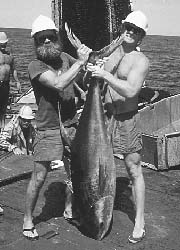 "I'd like a tuna-mahi mahi-shark-ray-wahoo-yellowtail-rainbow
runner-billfish-anchovy-herring-sardine-sea bass-sea turtle sandwich please."
"I'd like a tuna-mahi mahi-shark-ray-wahoo-yellowtail-rainbow
runner-billfish-anchovy-herring-sardine-sea bass-sea turtle sandwich please."
by Carolyn Chase
 una fishing has long been a traditional part of San
Diego's local culture. It's a straight shot down from San Diego harbor to
the sea-lanes of the Eastern Tropical Pacific, home of the biggest, tastiest
tuna. For many decades, visitors to downtown wharfs were greeted by the
sight of the huge fishing boats with their nets spread out on the dock for
mending.
una fishing has long been a traditional part of San
Diego's local culture. It's a straight shot down from San Diego harbor to
the sea-lanes of the Eastern Tropical Pacific, home of the biggest, tastiest
tuna. For many decades, visitors to downtown wharfs were greeted by the
sight of the huge fishing boats with their nets spread out on the dock for
mending.
 Although tuna fishing continues unabated and San Diego
is still home to some fleet owners, administrators and canners, the boats
are gone from our waters. The reasons for this exodus weave a complex web
of international politics, public opinion and environmental protection.
Although tuna fishing continues unabated and San Diego
is still home to some fleet owners, administrators and canners, the boats
are gone from our waters. The reasons for this exodus weave a complex web
of international politics, public opinion and environmental protection.
Sorry, Charlie
Oddly enough, dolphins - the denizens of the sea most beloved by humans
(especially those who watched the TV show "Flipper" as kids) -
have been the main source of difficulties for the tuna industry. The problem
is, "Charlie the Tuna" (another TV ad icon from the 70s) is not
just sitting around in the ocean playing with his friends. Tuna like to
race around at high speeds with dolphins - no one knows exactly why. It's
common to find dolphins, which must swim at or near the ocean surface to
breathe, zooming around directly over a large school of tuna.
 While tuna swimming 200 feet below the surface can be
difficult for fishermen to find, spotting a school of frolicking dolphins
is relatively easy. These "cowboys of the sea" then round up their
"herd" with big scoop-like nets called purse seines. The net,
which can be almost a mile long and extend 500 feet below the surface, is
spread in a circle around the school of dolphins (and tuna below). When
the circle is complete, the "purse" closes, trapping everything
within its diameter.
While tuna swimming 200 feet below the surface can be
difficult for fishermen to find, spotting a school of frolicking dolphins
is relatively easy. These "cowboys of the sea" then round up their
"herd" with big scoop-like nets called purse seines. The net,
which can be almost a mile long and extend 500 feet below the surface, is
spread in a circle around the school of dolphins (and tuna below). When
the circle is complete, the "purse" closes, trapping everything
within its diameter.
 This practice results in what scientists call "bycatch"
- all the stuff that just happened to be in the wrong place at the wrong
time. In the fisheries of the Eastern Tropical Pacific, this meant killing
lots of dolphins and a long list of other species.
This practice results in what scientists call "bycatch"
- all the stuff that just happened to be in the wrong place at the wrong
time. In the fisheries of the Eastern Tropical Pacific, this meant killing
lots of dolphins and a long list of other species.
 Bycatch is the key "dirty secret" of the fishing
industry and is especially severe with shrimp and tuna fishing. The fishermen
want to catch a specific species that they have a market for; their boat
is designed to store and transport that species only. The bycatch is just
waste, a by-product of doing business, and generally dumped over the side.
Bycatch is the key "dirty secret" of the fishing
industry and is especially severe with shrimp and tuna fishing. The fishermen
want to catch a specific species that they have a market for; their boat
is designed to store and transport that species only. The bycatch is just
waste, a by-product of doing business, and generally dumped over the side.
 But the love of "Flipper" changed all that.
When the kids of America found out that eating tuna meant killing Flipper,
they flipped. Potentially high dolphin mortality was first reported in 1968
and the Marine Mammal Protection Act of 1972 brought increased scrutiny.
But is wasn't until 1990 that dramatic films of slaughtered dolphins provided
public exposure of the incredible waste and disregard for marine mammals.
Earth Island Institute promoted this footage with such success that tuna
canners were compelled by consumers to become "dolphin safe."
The canners realized it would be extremely bad for business if too many
children decided they would no longer eat tuna caught with dolphins.
But the love of "Flipper" changed all that.
When the kids of America found out that eating tuna meant killing Flipper,
they flipped. Potentially high dolphin mortality was first reported in 1968
and the Marine Mammal Protection Act of 1972 brought increased scrutiny.
But is wasn't until 1990 that dramatic films of slaughtered dolphins provided
public exposure of the incredible waste and disregard for marine mammals.
Earth Island Institute promoted this footage with such success that tuna
canners were compelled by consumers to become "dolphin safe."
The canners realized it would be extremely bad for business if too many
children decided they would no longer eat tuna caught with dolphins.
 The results of public opinion were dramatic. In 1975,
the United States consumed about 85 percent of the yellowfin tuna from the
eastern Pacific. By the end of 1992, this figure was less than 10 percent.*
The results of public opinion were dramatic. In 1975,
the United States consumed about 85 percent of the yellowfin tuna from the
eastern Pacific. By the end of 1992, this figure was less than 10 percent.*
Michael, row your boat offshore
Over time, more and more U.S. boats left the country. In 1960, U.S. vessels
accounted for about 85 percent of the capacity of the international tuna
fleet in the eastern Pacific. By 1984, this had declined to 35 percent.
After the canners' announcement of their dolphin-safe policy in 1990, most
remaining U.S. vessels were transferred to foreign registry or sold. This
put the problem out of direct reach of U.S. domestic regulations, increasing
the pressures to work internationally to resolve issues.
 The inability to sell the catch in the United States
has resulted in the development of large international markets in Central
and South America, and especially in Mexico where tuna is a relatively inexpensive
source of animal protein. During the same period in which U.S. consumption
fell from 85 to 10 percent, Mexico's internal consumption rose from about
20,000 tons to about 100,000 tons. The rate of increase was similar in the
other fishing nations.* This new demand for tuna is expected to grow.
The inability to sell the catch in the United States
has resulted in the development of large international markets in Central
and South America, and especially in Mexico where tuna is a relatively inexpensive
source of animal protein. During the same period in which U.S. consumption
fell from 85 to 10 percent, Mexico's internal consumption rose from about
20,000 tons to about 100,000 tons. The rate of increase was similar in the
other fishing nations.* This new demand for tuna is expected to grow.
Bycatch by any other name still smells fishy
Though reduced and restricted, the U.S. market is still formidable and pays
top dollar. While some boats continued to fish 'on-dolphin' and sell to
other markets, most of the American fishing boats moved to the western Pacific
where the bycatch has a different makeup. These western Pacific tuna are
younger, smaller, and basically don't hang out with dolphins (speculation
is that they can't swim fast enough to keep up). This is now where most
of the "dolphin safe" tuna sold in the United States comes from.
 The problem is the bycatch that comes with it. While
there are fewer dolphin killed, there are still a host of other species
being sacrificed. By total count, there can be even greater waste than in
the Eastern Tropical Pacific - it just doesn't include dolphin.
The problem is the bycatch that comes with it. While
there are fewer dolphin killed, there are still a host of other species
being sacrificed. By total count, there can be even greater waste than in
the Eastern Tropical Pacific - it just doesn't include dolphin.
 Have these political and media-fomented changes translated
into a better or worse conditions in the fisheries themselves?
Have these political and media-fomented changes translated
into a better or worse conditions in the fisheries themselves?
Dolphin politics
Given the local tuna connection, I was not surprised when I received a call
from Congressman Brian Bilbray's office inviting me to attend a presentation
on the politics and science of tuna and the environment.
 Bilbray, along with other area Republican congressmen,
Cunningham, Packard, and Hunter, are promoting a bill (HR 2823) to amend
the Marine Mammal Protection Act and the Dolphin Protection Consumer Information
Act. He calls it the "International Dolphin Conservation Program Act."
Earth Island Institute calls it the "Dolphin Death Bill." Given
the Republican penchant for defunding and dismantling environmental protections,
I was prepared for the worst.
Bilbray, along with other area Republican congressmen,
Cunningham, Packard, and Hunter, are promoting a bill (HR 2823) to amend
the Marine Mammal Protection Act and the Dolphin Protection Consumer Information
Act. He calls it the "International Dolphin Conservation Program Act."
Earth Island Institute calls it the "Dolphin Death Bill." Given
the Republican penchant for defunding and dismantling environmental protections,
I was prepared for the worst.
 But these local politicians are not alone. Also signing
on to the changes are a formidable array of environmental organizations
including Greenpeace and the Center for Marine Conservation. Neither of
these organizations is known for selling out marine ecosystems. However,
they are being accused of "undermining 20 years of progress to stop
the dolphin slaughter" by EII, and "bringing us closer to the
day when dolphin-deadly tuna will again be sold in U.S. supermarkets,"
according to the Humane Society of the United States.
But these local politicians are not alone. Also signing
on to the changes are a formidable array of environmental organizations
including Greenpeace and the Center for Marine Conservation. Neither of
these organizations is known for selling out marine ecosystems. However,
they are being accused of "undermining 20 years of progress to stop
the dolphin slaughter" by EII, and "bringing us closer to the
day when dolphin-deadly tuna will again be sold in U.S. supermarkets,"
according to the Humane Society of the United States.
 Why? And why now? How has the process of U.S. legislation
and embargoes impacted the fisheries and the people who are connected to
it? What has been the impact on the businesses and on the tuna ecosystems?
Which environmental groups are we to believe?
Why? And why now? How has the process of U.S. legislation
and embargoes impacted the fisheries and the people who are connected to
it? What has been the impact on the businesses and on the tuna ecosystems?
Which environmental groups are we to believe?
What science says
The presenter at Congressman Bilbray's event was Dr. Martin Hall, Head of
the Tuna-Dolphin Program for the Inter-American Tropical Tuna Commission
(IATTC), working out of Scripps Institution of Oceanography. The IATTC was
established in 1949 to study the Eastern Tropical Pacific (ETP) fishery
and make recommendations to its members' governments for the responsible
exploitation of the fishery. His research includes sending observers out
on an impressive number of expeditions to observe fishing practices and
measure bycatch.
 Recent bycatch studies are good news for dolphin lovers,
but they paint a picture of other wasted species that cannot be ignored
by those concerned with ecosystem health and protection.
Recent bycatch studies are good news for dolphin lovers,
but they paint a picture of other wasted species that cannot be ignored
by those concerned with ecosystem health and protection.
His conclusion: "If we replace dolphin-tuna sets with other sets, incidental
dolphin-kill is almost eliminated, but at the effect of other species."
 Dr. Hall's data show incidental dolphin mortality has
been reduced by 97 percent, from 133,000 in 1986 to 3,600 in 1993 in the
eastern Pacific. This success is the result of a series of technological
developments developed by the fishermen themselves in response to legal
and political developments. A typical bycatch of fishing "on dolphins"
now includes only two sharks, 29 dolphins, five billfish, and an average
of less than one sea turtle. By contrast, the bycatch from other fishing
methods nets an average of 2950 sharks, 102 billfish, less than one dolphin
(on average), and eight sea turtles.
Dr. Hall's data show incidental dolphin mortality has
been reduced by 97 percent, from 133,000 in 1986 to 3,600 in 1993 in the
eastern Pacific. This success is the result of a series of technological
developments developed by the fishermen themselves in response to legal
and political developments. A typical bycatch of fishing "on dolphins"
now includes only two sharks, 29 dolphins, five billfish, and an average
of less than one sea turtle. By contrast, the bycatch from other fishing
methods nets an average of 2950 sharks, 102 billfish, less than one dolphin
(on average), and eight sea turtles.
 Hall asks, "What is boils down to is, what are
we willing to sacrifice for a dolphin?"
Hall asks, "What is boils down to is, what are
we willing to sacrifice for a dolphin?"
 Earth Island counters: "This legislation, would
increase bycatch because it would attract more vessels back to the ETP.
U.S. vessels currently operating in the Western Tropical Pacific would be
free to return to set nets on dolphins, in addition to other methods. By
lifting embargoes and opening lucrative U.S. markets to tuna caught by chasing
and netting dolphins, in which no dolphins are "observed" killed,
a new major incentive would be provided for more vessels to enter the international
fleet. Even if vessels and countries comply with the IATTC Dolphin Mortality
Limits, when these vessels reach the allowable limits, they will then be
able to continue to fish the remainder of the year using other methods,
resulting in increased bycatch."
Earth Island counters: "This legislation, would
increase bycatch because it would attract more vessels back to the ETP.
U.S. vessels currently operating in the Western Tropical Pacific would be
free to return to set nets on dolphins, in addition to other methods. By
lifting embargoes and opening lucrative U.S. markets to tuna caught by chasing
and netting dolphins, in which no dolphins are "observed" killed,
a new major incentive would be provided for more vessels to enter the international
fleet. Even if vessels and countries comply with the IATTC Dolphin Mortality
Limits, when these vessels reach the allowable limits, they will then be
able to continue to fish the remainder of the year using other methods,
resulting in increased bycatch."
 In addition, "Claims that high sea turtle kills
are intrinsic to ETP purse seining are bogus. The killing of sea turtles
in purse seining is dwarfed by the true culprit of sea turtle mortality,
the shrimp trawling fleet [see next article].
By any standard, the shrimp fleet results in a sea turtle take at least
1,000 times larger than any ETP tuna fleet. Secondly, in the rare instances
in which sea turtles are entangled in a tuna set, the vast majority can
be released alive."
In addition, "Claims that high sea turtle kills
are intrinsic to ETP purse seining are bogus. The killing of sea turtles
in purse seining is dwarfed by the true culprit of sea turtle mortality,
the shrimp trawling fleet [see next article].
By any standard, the shrimp fleet results in a sea turtle take at least
1,000 times larger than any ETP tuna fleet. Secondly, in the rare instances
in which sea turtles are entangled in a tuna set, the vast majority can
be released alive."
The La Jolla Agreement
While scientists and fishermen have worked to improve practices at sea,
the politics has continued to escalate on land.
 In 1991, Mexico successfully pressed a claim that unilateral
U.S. embargoes of dolphin-unsafe tuna were in violation of the General Agreement
of Trade and Tariffs. This action increased pressures to develop international
agreements that could protect fisheries and bind fishing nations.
In 1991, Mexico successfully pressed a claim that unilateral
U.S. embargoes of dolphin-unsafe tuna were in violation of the General Agreement
of Trade and Tariffs. This action increased pressures to develop international
agreements that could protect fisheries and bind fishing nations.
 In 1992, ten nations involved in the ETP fishery, meeting
in La Jolla, signed The La Jolla Agreement with two objectives:
In 1992, ten nations involved in the ETP fishery, meeting
in La Jolla, signed The La Jolla Agreement with two objectives:
- To progressively reduce dolphin mortality in the fishery to levels approaching
zero through the setting of annual limits.
- Eliminating dolphin mortality in the fishery, seeking ecologically sound
means of capturing large yellowfin tunas not in association with dolphins
while maintaining the populations of yellowfin tuna at a level that will
permit maximum sustained catches year after year.
The mortality reduction program would limit dolphin deaths to less than
5,000 animals by 1999. By comparison, dolphin mortality in 1990 was 53,000
animals. A creative formula was worked out so that each fishing vessel would
be competing against its own ability to reduce dolphin mortality, not against
other vessels for a share of a limited quota of fish. Thus, careful operators
would not be hurt by careless ones. Compliance would be verified by observers
on every trip made by large vessels.
 According to a joint statement released by the Center
for Marine Conservation, the Environmental Defense Fund, Greenpeace, The
National Wildlife Federation and the World Wildlife Fund, "The system
established in the La Jolla Agreement has shown it can be successful in
moving toward our goal of eliminating dolphin mortality... Since 1992, dolphin
mortality has declined under the La Jolla Agreement by 75 percent."
According to a joint statement released by the Center
for Marine Conservation, the Environmental Defense Fund, Greenpeace, The
National Wildlife Federation and the World Wildlife Fund, "The system
established in the La Jolla Agreement has shown it can be successful in
moving toward our goal of eliminating dolphin mortality... Since 1992, dolphin
mortality has declined under the La Jolla Agreement by 75 percent."
 These results formed the basis for the next phase, The
Panama Declaration. This agreement was signed last October by the governments
of Belize, Colombia, Costa Rica, Ecuador, France, Honduras, Mexico, Panama,
Spain, United States, Vanuatu and Venezuela and agrees to bind these nations
to improved fishing practices, while continuing to pursue low dolphin mortality
and decreased bycatch.
These results formed the basis for the next phase, The
Panama Declaration. This agreement was signed last October by the governments
of Belize, Colombia, Costa Rica, Ecuador, France, Honduras, Mexico, Panama,
Spain, United States, Vanuatu and Venezuela and agrees to bind these nations
to improved fishing practices, while continuing to pursue low dolphin mortality
and decreased bycatch.
On the house
The Panama Declaration is triggering proposed legislative changes in the
United States. By requiring increased accountability, limits and cooperation
among the fishing nations, the United States must agree to reopen its markets
to tuna fished on-dolphin. This is thought by the environmental groups at
the table to be the best way to provide for overall ecosystem health, rather
than focus strictly on dolphins. "H.R. 2823 is needed to lock in the
international commitments of the Panama declaration and there is strong
domestic and international support for increased protection of dolphins
and other species," said Clifton Curtis of Greenpeace.
 "H.R. 2823 provides a base for building strong,
permanent, international protection for dolphins, for the ecosystems in
which they live, and for consumers who purchase tuna," states Nina
Young a marine mammalogist with the Center for Marine Conservation. "The
combined impacts of these internationally agreed upon management mechanisms
will continue to drive bycatch down."
"H.R. 2823 provides a base for building strong,
permanent, international protection for dolphins, for the ecosystems in
which they live, and for consumers who purchase tuna," states Nina
Young a marine mammalogist with the Center for Marine Conservation. "The
combined impacts of these internationally agreed upon management mechanisms
will continue to drive bycatch down."
 But for the dolphin-protection groups - even though
the numbers of dolphins killed have been greatly reduced - allowing any
tuna caught on-dolphin to be sold in the U.S. market, especially under the
label dolphin-safe, is simply selling out.
But for the dolphin-protection groups - even though
the numbers of dolphins killed have been greatly reduced - allowing any
tuna caught on-dolphin to be sold in the U.S. market, especially under the
label dolphin-safe, is simply selling out.
 According to Earth Island, one of the most damaging
aspects of proposed changes to United States is the transfer of enforcement
from the United States to the IATTC. According to the Winter 1995/1996 issue
of the Earth Island Journal, "This self-regulating, industry-dominated
organization promotes dolphin-unsafe fishing practices, grants annual dolphin-kill
quotas and recommends fines against member nations who violate its articles.
Since its inception in 1949, no IATTC member nation has ever levied a single
fine against one of its vessels, despite thousands of documented violations
(516 in 1994 alone)."
According to Earth Island, one of the most damaging
aspects of proposed changes to United States is the transfer of enforcement
from the United States to the IATTC. According to the Winter 1995/1996 issue
of the Earth Island Journal, "This self-regulating, industry-dominated
organization promotes dolphin-unsafe fishing practices, grants annual dolphin-kill
quotas and recommends fines against member nations who violate its articles.
Since its inception in 1949, no IATTC member nation has ever levied a single
fine against one of its vessels, despite thousands of documented violations
(516 in 1994 alone)."
 Hall responds, "They are trying to do by political
force what is ecologically stupid. For those who favor the continued use
of embargoes to threaten other countries, there is little sensitivity to
other cultural reactions or practicalities. We need to move beyond confrontation
to what is sound for the entire ecosystem - people, fish, dolphin and the
sea. This is why you see a group like Greenpeace supporting this."
Hall responds, "They are trying to do by political
force what is ecologically stupid. For those who favor the continued use
of embargoes to threaten other countries, there is little sensitivity to
other cultural reactions or practicalities. We need to move beyond confrontation
to what is sound for the entire ecosystem - people, fish, dolphin and the
sea. This is why you see a group like Greenpeace supporting this."
 The politics of tuna has divided fishing interests and
environmental interests alike.
The politics of tuna has divided fishing interests and
environmental interests alike.
 But one fact is irrefutable: the living resources of
the open ocean exist in an environment foreign to humans and are difficult
to monitor and control. The same may be said of the humans who make their
way of life by pursuing them. Each pays little heed to man-made boundaries
and passes unhindered from national to international waters, making their
management contentious and difficult.
But one fact is irrefutable: the living resources of
the open ocean exist in an environment foreign to humans and are difficult
to monitor and control. The same may be said of the humans who make their
way of life by pursuing them. Each pays little heed to man-made boundaries
and passes unhindered from national to international waters, making their
management contentious and difficult.
 As for you and me and Charley, spending a portion of
my life pouring through several pounds of reports, press releases and treaty-related
documents on tuna and dolphin has made it much easier to forsake eating
of most kinds of tropical seafood. The key conclusion I can give to anyone
who feels a moral obligation and kinship to dolphin - and particularly to
the other species caught while living nearby - is simple: don't eat tuna
and encourage your friends to stop. For those who realize that fishing will
continue yet still want to try and reduce the messier aspects of predator
relations via international cooperation, the proposed changes are the way.
As for you and me and Charley, spending a portion of
my life pouring through several pounds of reports, press releases and treaty-related
documents on tuna and dolphin has made it much easier to forsake eating
of most kinds of tropical seafood. The key conclusion I can give to anyone
who feels a moral obligation and kinship to dolphin - and particularly to
the other species caught while living nearby - is simple: don't eat tuna
and encourage your friends to stop. For those who realize that fishing will
continue yet still want to try and reduce the messier aspects of predator
relations via international cooperation, the proposed changes are the way.

Carolyn Chase is chairperson of the City of San Diego Waste Management
Advisory Board, a member of the Peñasquitos Canyon Citizens Advisory
Council and recipient of the mayor's 1994 Spirit of San Diego award for
the Environment.

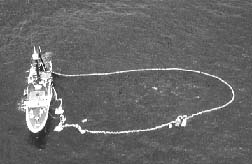
A tuna boat - purse seiner - with spread net. The objects at the lower
right are small boats that help distribute the nets. When the circle is
complete, the bottom of the net is closed, trapping all sea creature within.
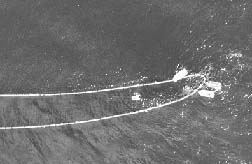
This photo illustrates the "backdown" procedure that allows
the dolphins to escape. After the "purse" is closed, the seiner
drags the net away from the dolphins, concentrating them at the narrow point.
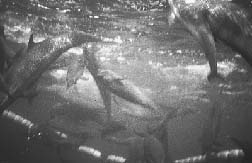
Water pressure causes the net at the point to drop, allowing the dolphins
to escape. The tuna, which typically swim several hundred feet below the
surface, are still trapped.
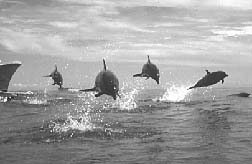
These dolphin have just escaped from the seiner net. It's always questionable
to attribute human emotions to other species, but one imagines that these
dolphins are happy to be free.
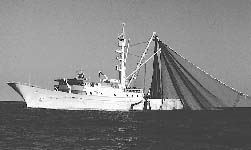
Tuna seiner pulling in a full net - minus dolphins.






"I'd like a tuna-mahi mahi-shark-ray-wahoo-yellowtail-rainbow runner-billfish-anchovy-herring-sardine-sea bass-sea turtle sandwich please."




